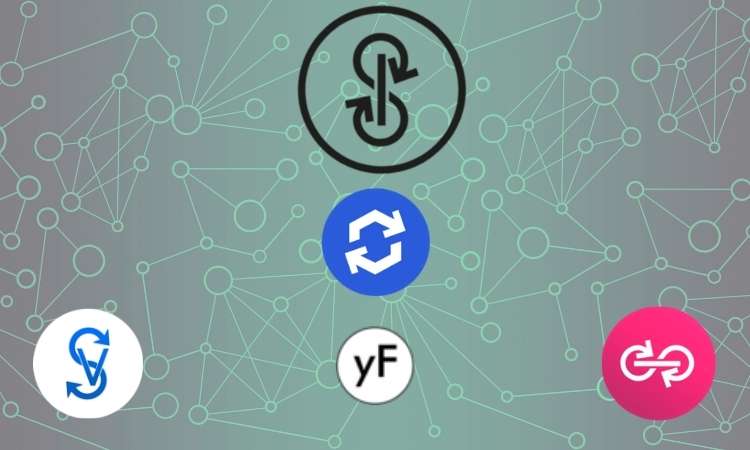
Have you heard about Yearn Finance’s YFI token? It acts as a governance token for its decentralized finance platform.
It broke Bitcoin’s record of the all-time high in terms of USD prices. The YFI token attained highs of over $38,000 in August and even peaked above $43,000 in mid-September 2020.
Do you know what’s the difference between the YFI project and other majority governance tokens in DeFi? Scarcity! Yes, there’s a very limited supply of YFI tokens. The maximum supply can never exceed 30,000 YFI tokens. At the moment, there are 29,968 YFI tokens in circulation already, according to CoinMarketCap.
This article takes a look at all the different Yearn Finance projects and forks. Let’s learn what’s unique about each project and why it has been created? If you are not very familiar with yield farming, check out our detailed guide on yield farming.
We’ll cover the following projects:
- Yearn Finance (YFI)
- Yearn Finance Fork (YFII) – DFI.money
- Yearn Value (YFV)
- Yearn Finance Link (YFL)
- Yearn Fuel (YFUEL)
#1. Yearn Finance (YFI)
Yearn Finance began its operations in February 2020 with another project known as iEarn Finance. Going further, iEarn was rebranded as yEarn by Andre Cronje. You can look at yEarn as the first professional attempt at creating a yield farming project. However, yEarn has a few more capabilities added to its arsenal.
Yearn Finance is a DeFi platform where users can deposit and stake their ERC20 tokens. In return, they receive daily interest. This is made possible by allocating the capital to staking pools offering best returns across the network.
Why was this so revolutionary? Before yield farming got mainstream, users had to stake individually with each protocol, having to learn about many projects. Using the Yearn project, users didn’t have to flip through multiple DeFi sites to get yield farming profits. Yearn solved this problem by integrating many different blockchain protocols. So, you only have to stake tokens once with Yearn to get access to many interest-yielding blockchain protocols. To maximize profits, the Yearn protocol continuously rebalances as yield-farming opportunities shift.
I don’t think y’all heard me. 1 $YFI = $100,000. pic.twitter.com/IGirAovezB
— Arthur Hayes (@CryptoHayes) August 30, 2020
#2. Yearn Finance Fork (YFII) – DFI.money
YFII was forked by the crypto community of China from YFI. YFII is YFI’s first fork. The YFII token is the hottest currency today in the Chinese DeFi ecosystem. The YFII fork has been created because a governance vote for YFI wanted to introduce weekly halvening to the project, referred to as the YIP-8 proposal.
However, this proposal failed to pass. Therefore, the YFII fork has been created, implementing the halvening proposal. In other words, the YFII project has a 98% code similarity with the YFI project.
The maximum supply of YFII has been capped to 40,000. The initial perception of YFII was that it is a scam. Hence, Balancer had blacklisted the token. However, the YFII token is doing quite well today, and its recent ATH was $6000.
#3. YFValue (YFV)
YFValue, denoted by YFV, is a fork of YFII. It was announced on August 16th, 2020, through a Medium post. So, what’s the role of the YFV token? It acts as a governance token of the YFValue protocol. They aim to make yield farming accessible to all users worldwide. They want to make yield farming more inclusive to achieve their mission of accessibility: “Bring farming to everyone.”
Now, the question arises – does YFV have any unique feature? It indeed does. YFV token grants its holders a right of voting to control the rate of the supply and also the referral system. The burning of the token is automated and happens fully on-chain. The maximum supply of YFV tokens has been capped at 15,750,000.
Furthermore, among YFValue’s mission, we can find “insurance.” The goal is to use “an insurance treasury through contributions of the YFV team and community funds to engage and integrate an insurance protocol, such as Nexus Mutual, to further reduce risk on behalf of all YFV stakeholders.”
#4. Yearn Finance Link (YFL)
Yearn Finance Link is popularly known through its ticker symbol YFL. It was announced through a Medium post dated August 7th, 2020. It’s a modified version of the YFI tokens.
The project wants to leverage the DeFi-backed governance token to achieve more for the Chainlink supporters. You must have already understood by now that this project has its origin in the Chainlink community.
The YFL development team took Andre Cronje’s YFI project and forked it. They adapted it to allow for staking LINK. Later on, they also brought the concept of yield farming to LINK holders. The maximum supply is capped at 85,000. Many analysts call YF Link the connecting bridge between ChainLink and Yearn Finance.
To give a quick example, you can deposit LINK and YFLINK tokens into a Balancer pool, giving you BPT tokens. Next, those BPT tokens can be staked with the YFLINK pool. That means you can both earn YFLINK from the YFLINK pool and BPT from the Balancer pool. Moreover, Yearn Finance Link hosts five different pools, all with their unique configurations for increasing yield.
#5. Yearn Fuel (YFuel)
The project aims to make Yearn Finance genuinely accessible. It wouldn’t matter if a user is a big whale or small investor as Yearn Fuel wants to make Yearn Finance accessible to everyone.
It has some very unique features, which include the right of voting to control the inflationary rate of the supply. Additionally, the YFuel token will also grant the user a right to vote on the referral system. It comes with automatic burning, and the whole burning happens fully on-chain.
They are also implementing a new economic model of token burning. They have named it “Grafuel.” Under the Grafuel model, they will burn as much as 1% of the total token supply per month, starting from the 15th of each month. The idea behind this model of token burning is that it will lead to an increase in liquidity.
Wrapping Up the Yearn Finance Universe
It’s interesting to see so many Yearn Finance clones pop up to satisfy the different needs yielders might have. However, this has opened up another wave of crypto scams where people quickly create a new Yearn Finance clone with slightly modified rules. We see the same crypto craze as when the ICO boom happened. People throw in money blindly into those yield farming projects expecting significant returns.
However, we can’t deny that yield farming has proven to be an excellent case for DeFi and even got the momentum to convert bearish into bullish momentum for crypto markets.
YFI tokens were initially envisioned to be valueless, but that’s not going to happen anymore. It is quite obvious from the rising prices of YFI and its clones.
So, how long can this boom last? These tokens do have good use cases, and their limited supply is driving their prices high. The success of yield aggregation platforms has helped YFI clones take off as well. Some of the YFI clones may get lost in time. But we sure are witnessing something incredible.
Click here to start trading on BitMEX and receive 10% discount on fees for 6 months.
The post appeared first on CryptoPotato






